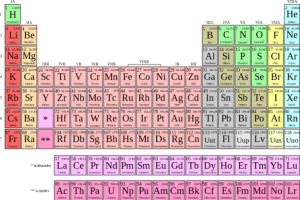Playlist
Show Playlist
Hide Playlist
Introduction – Quantum Numbers
-
Slides 02 Chemistry Basics Le Gresley.pdf
-
Download Lecture Overview
00:01 Okay, so let's talk about quantum numbers in a little bit more detail. We introduced the concept in the last lecture, where we talked about their importance in understanding where electrons were. But when we are building up electrons within the periodic table, and we are moving from left to right, and we are adding electrons, as we increase the groups, we go up the group from sodium on one side to the noble gases on the other, what we need to do is understand more about where the electrons are for each individual atom. 00:34 So I introduced the idea of the principle quantum number, which has the letter n associated with it; the orbital quantum number, l; and also the magnetic quantum number, m. Okay? So what we are going to be doing now is to better understand how electrons are filling these orbitals as we go across the periodic table and also as we go down the periodic table. So we have a picture of where electrons need to go: obviously, nowhere near the nucleus; that's the preserve of the neutron and the proton. And we know how many electrons there should be in any atom of any element. But we now need to understand some way of telling us where the electrons will go. And there are three rules that we are using in this case to understand how this happens: the Pauli exclusion principle, the Aufbau principle, and also Hund's rule. And each of these will enable you to predict the electron configuration of any atom or ion. 01:42 The Pauli exclusion principle states that in any atom, no two electrons may have a set of quantum numbers with the same values. But there is a problem. In a 1s orbital, there can be two electrons, so both will have the same quantum numbers, surely, which is n, principle quantum number 1; l, because it is an s orbital; and, of course, ml, because it is spherical, and therefore, it is not possible to have more than one orientation. 02:14 And that is where we consider the magnetic spin quantum number, or ms. If we imagine an electron, for a second, as a particle, it can rotate on its axis, and this is shown by the diagram on the board. As you can see, you have positive spin configuration and negative spin configuration. This is where the electrons are either rotating in a clockwise or an anticlockwise direction. Electrons with the same spin direction are said to have parallel spins, whereas those with different spin directions are said to have antiparallel spins. 03:03 So if we go back to what we said before, we look at a simple 1s orbital, we can see, by the incorporation of this additional quantum value (the ms quantum value) that the first rule is preserved. That is to say, we actually have two different overall quantum configurations for the electrons in this s orbital where, as you can see at the bottom of the board, we can denote these by two arrows: one heading up and one heading down. This is known as the pairing of electrons, and they are often represented in a box form, as you can see on the board as well, where the line running from left to right or right to left represents the orbital concerned (in this case, the 1s orbital) and the direction of the electron spin is shown by the arrows, pointing either up or down.
About the Lecture
The lecture Introduction – Quantum Numbers by Adam Le Gresley, PhD is from the course Chemistry: Introduction.
Included Quiz Questions
What are the four quantum numbers used to describe the electronic configuration of an atom?
- n, l, ml and ms
- n, o, p and q
- ml, n, o and ps
- n, la, bs and c
- p, q, r and ms
What does the Pauli exclusion principle say?
- No two electrons in an atom can share the same set of quantum numbers.
- At least two electrons in an atom should have the same set of quantum numbers.
- At least three electrons in an atom should have the same set of quantum numbers.
- Two electrons having the same n, l and m quantum numbers will naturally share the same s quantum number.
- No two protons in an atom can share the same set of quantum numbers.
How many sets of quantum numbers are possible for electrons of an He (atomic number 2) atom?
- 2
- 1
- 4
- 3
- 5
Complete the following statement. Two electrons present in the 2px orbital of an atom will ...
- ... have opposite spins to each other.
- ... be spinning clockwise.
- ... be spinning anti-clockwise.
- ... have parallel spins.
- ... not spin at all.
Customer reviews
5,0 of 5 stars
| 5 Stars |
|
1 |
| 4 Stars |
|
0 |
| 3 Stars |
|
0 |
| 2 Stars |
|
0 |
| 1 Star |
|
0 |
Por que explicó detalladamente y con ejemplos la importancia del principio de exclusión de Pauli y que para que se cumpla en el orbital S, debemos considerar al numero cuantico spin




